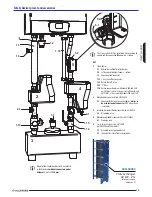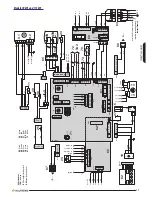
3
U
T
E
N
T
E
I
avvertenze per l’utente per l’uso
in sicurezza del gruppo termico
PREMESSA
Il libretto istruzioni fornito a corredo, costituisce parte integrante ed essenziale del gruppo termico.
Conservare con cura il presente libretto per ogni ulteriore consultazione. Queste avvertenze
si propongono di contribuire alla sicurezza nella utilizzazione dei componenti per impianti di
riscaldamento ad uso civile e produzione di acqua calda per uso sanitario, mediante l’indicazione di
quei comportamenti che è necessario ed opportuno adottare al fine di evitare che le loro originarie
caratteristiche di sicurezza risultino compromesse da eventuali installazioni non corrette, usi erronei,
impropri o irragionevoli. La diffusione delle avvertenze fornite da questa guida mira anche alla
sensibilizzazione del pubblico dei “consumatori” ai problemi della sicurezza mediante un linguaggio
necessariamente tecnico ma facilmente accessibile.
aVVertenZe GeneralI
- PER L'INSTALLAZIONE E' NECESSARIA L'OSSERVANZA DI TUTTE LE REGOLE RIGUARDANTI LE
CARATTERISTICHE, L'INSTALLAZIONE E L'USO DEGLI APPARECCHI A GAS, LA VENTILAZIONE
DEI LOCALI E LO SCARICO DEI PRODOTTI DELLA COMBUSTIONE PRESCRITTI DALLE NORME UNI
ATTUATIVE DELL'ART.3 DELLA LEGGE 1083/71 E DALLE DISPOSIZIONI DI LEGGE.
L'installazione del modulo termico deve essere effettuata, in ottemperanza delle norme vigenti
con riferimento alla legge 5/3/1990 n.46 (norme per la sicurezza degli impianti) e relativo
regolamento di applicazione DPR 26/8/1993 n.412, secondo le istruzioni del costruttore e
da personale professionalmente qualificato.
Per personale professionalmente qualificato s'intende quello avente specifica competenza
tecnica del settore dei componenti di impianti di riscaldamento ad uso civile e produzione
di acqua calda, come previsto dalla regolamentazione vigente.
- Un'errata installazione può causare danni a persone, animali o cose, per i quali il costruttore
non è responsabile.
-
Dopo aver tolto ogni imballaggio, assicurarsi dell'integrità del contenuto. In caso di dubbio non
utilizzare l'apparecchio e rivolgersi al fornitore. Gli elementi di imballaggio (graffe, sacchetti
di plastica, polistirolo espanso, ecc.) non devono essere lasciati alla portata di bambini in
quanto potenziali fonti di pericolo.
-
Prima di effettuare qualsiasi operazione di pulizia o di manutenzione, disinserire l'apparecchio
dalla rete di alimentazione agendo sull'interruttore dell'impianto e/o attraverso gli appositi
organi di intercettazione.
- Non ostruire le griglie di aspirazione o di dissipazione.
- In caso di guasto e/o di cattivo funzionamento dell'apparecchio, disattivarlo, astenendosi da
qualsiasi tentativo di riparazione o di intervento diretto. Rivolgersi esclusivamente a personale
professionalmente qualificato. L'eventuale riparazione dei prodotti dovrà essere effettuata
da personale professionalmente qualificato utilizzando esclusivamente ricambi originali.
Il mancato rispetto di quanto sopra può compromettere la sicurezza dell'apparecchio. Per
garantire l'efficienza dall'apparecchio e per il suo corretto funzionamento è indispensabile
fare effettuare, da personale professionalmente qualificato, la manutenzione annuale
attenendosi alle indicazioni del costruttore.
-
Allorché si decida di non utilizzare più l'apparecchio, si dovranno rendere innocue quelle parti
suscettibili di causare potenziali fonti di pericolo.
- Se l'apparecchio dovesse essere venduto o trasferito ad un altro proprietario bisogna
assicurarsi sempre che il libretto d'istruzioni accompagni l'apparecchio in modo che possa
essere consultato dal nuovo proprietario e/o dell'installatore.
- Per tutti gli apparecchi con optionals o kit (compresi quelli elettrici) si dovranno utilizzare
solo accessori originali.
- Questo apparecchio dovrà essere destinato solo all'uso per il quale è stato espressamente
previsto.
US
E
R
f
Before the installation, it is necessary to read carefully the technical instructions.
f
Before ignition, it is necessary:
•
to read carefully the use instructions
•
to fill the condensation collecting syphon as described on page 24
f
Boiler installation must be performed in compliance with legal provisions (M.D.
12/04/1996 and R dossier) and to UNI 11528 2014 standard or to a relevant
installation standard of a EEC country. In any case, it is necessary to remember to:
•
Clean thoroughly the heating system with water before connecting the boiler
to the system itself. In case of existing systems and/or particularly dirty, use
specific cleaning products having proven effectiveness, in correct quantities
according to producer's indications.
•
If the system has a power of up to 350 kW and water used to fill the system
has a total hardness of 35°fr, it is necessary to proceed to its softening in
order to reduce hardness, while if it has a total hardness between 15°fr. and
35°fr., a conditioning treatment is enough, aiming at ensuring that water
features are in compliance with the conditions of the UNI 8065 standard. For
systems with power greater than 350 kW, it is necessary to soften the water
used for filling if its hardness is greater than 15°fr. These water treatments
are necessary also in case of system filling.
•
For systems functioning at low temperatures, water treatment must be carried
out with a chemical product for water conditioning in the circuit with filming
(protection from corrosion and encrustation), bacteriological and anti-algae
action. It is recommended to use a specific chemical product having proven
effectiveness according to producer's indications.
•
For domestic hot water production systems, the UNI 8065 standard foresees
a safety filter to protect systems. Moreover, if water hardness is greater than
25°fr., it is necessary to use a softener to restore the hardness values under 25°fr.
•
If, in some areas of the heating system or in the boiler installation site, ambient
temperature can go below 0°C, it is advisable to pour an anti-freeze solution
specific for heating systems into the system (usually made of propylene glycol),
following the indications provided by the producer of anti-freeze liquid.
•
After filling the system, it is necessary to purge residual air present in the
heating system using air purging valves located on radiators or in the
distribution collector of underfloor heating systems.
f
For detailed descriptions of system filling and purging sequences, refer to the
instruction booklet of the boiler.
aDDItIonal oPeratIonS for conDenSInG BoIlerS:
f
When system is commissioned and in all cases of combustion unit cleaning and
following emptying, it is necessary to verify that there is no air in the combustion
unit primary circuit; should air be present, proceed to its elimination using the
purging valve located on top of the unit itself following the modes described in
the instruction booklet of the boiler.
CAUTION
I
nstructIons
for
the
u
ser
I
Warning notes for the user, for safe use of
the heating unit
FOREWORD
The instruction manual furnished with the unit is an essential and integral part of the equipment.
Keep the instruction manual handy for further consultation. These warning notes are aimed at
ensuring the safe use of the components of heating systems for domestic use and the production
of hot water. They indicate the proper behaviour to prevent the original safety features from be-
ing jeopardized by improper or wrong installation and by improper, wrong or unreasonable use.
The warning notes provided in this guide also seek to make the consumer more aware of safety
problems in general, using necessarily technical but easily understood language.
General WarnInG noteS
FOR THE INSTALLATION IT IS STRICTLY NECESSARY TO COMPLY WITH ALL THE REGULATIONS RELATING
TO THE CHARACTERISTICS, INSTALLATION AND USE OF GAS-FIRED EQUIPMENT, ROOM VENTILA-
TION AND THE DISCHARGE OF THE COMBUSTION PRODUCTS, AS PER THE UNI IMPLEMENTATION
STANDARDS OF ARTICLE 3 LAW 1083/71 AND LEGAL PROVISIONS.
Installation of the thermal unit must be carried out in accordance with all the latest legally
required safety standards, with reference to law No.46 5/3/1990 (System Safety Standards)
and application standard Presidential Decree No. 412 26/8/1993, following the manufacturer’s
instructions and by specially trained staff.
The term ‘qualified personnel’ refers to those specifically trained in the field of heating systems
for domestic use and domestic hot water systems, as foreseen by regulations in force.
- Improper installation can cause injuries to people and animals and damage to property, for
which the manufacturer is not responsible.
- After removing the packaging check that there are no broken or missing parts. If in doubt, do
not use the equipment and contact your supplier. The packing (wooden crates, clips, plastic
bags, polystyrene foam, etc.) are potentially dangerous and must be kept away from children.
-
Before carrying out any cleaning or servicing, switch off the equipment from the main supply,
using the system’s switch or shut-off devices.
- Do not obstruct the ventilation grilles or heat dissipation grilles.
- If there is any fault or if the equipment is not working properly, de-activate the equipment
and do not attempt to repair it or tamper with it directly. Contact only qualified personnel.
Any repair must be carried out by qualified personnel. Only original spare parts must be used.
Failure to observe the above instructions can endanger the safety of the system. To guarantee
efficiency and top performance, the system must be serviced annually by qualified personnel.
The manufacturer's instructions must be followed.
- If the equipment is not to be used, any potentially dangerous parts should be rendered
harmless.
- If the equipment is sold or transferred to a different owner, make sure that the user manual
is dispatched together with the equipment so that the new owner and/or installer can read
it.
- Only original accessories must be used on systems with optional extras or kits (including
electrical parts).
- This equipment should only be used for the purpose for which it was expressly designed.
Any other use is to be considered improper and therefore dangerous.
The manufacturer accepts no liability for any damage caused by improper installation and
use or in case of non-compliance with the manufacturer's instructions.
Important: this thermal module is for heating water at a temperature below
boiling point at atmosphere pressure . It must be connected to a heating system
and/or to a domestic hot water system and must function within its performance
and output limits .
Summary of Contents for Time Power 115 K
Page 42: ...42 Notes...
Page 43: ...43 Notes...




































